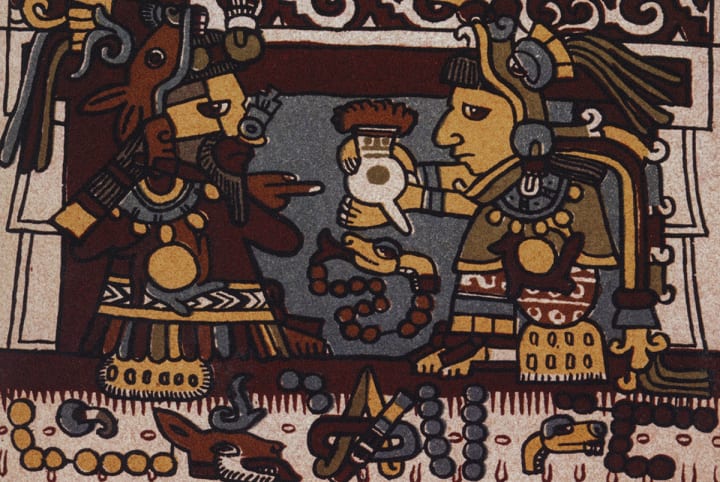Chocolate: The Sweetest Drug
As delightful as it is, chocolate is a drug, and kids are getting high on it every day.

The emperor was Moctezuma II, last ruler of the Aztec Empire of Mexico, and his addiction to chocolate like a drug, was revealed to us by Bernal Díaz, a Spanish soldier under the conquistador Hernando Cortés who destroyed Moctezuma’s empire in 1521. The beverage that so captivated Moctezuma was actually called cacahuatl by the Aztecs, which Díaz corrupted to chocolatl, from which chocolate and other modern names derive.
Cacahuatl is the seed of Theobroma cacao, today called the cacao bean. The active principle of the cacao bean is theobromine, a drug closely related to caffeine. The Aztec cacao drink was very different from modern brews. It was prepared by grinding corn and cacao beans together and boiling this meal with chili and other spices.
The ancient Aztecs held cacahuatl in the highest esteem. The seeds of this wondrous plant were said to have been brought to man from Paradise by the legendary god-king, Quetzalcoatl. Bernal Díaz tells us that Moctezuma drank his cacahuatl from golden goblets which were discarded after use. Diaz attributed aphrodisiac properties to cacahuatl, Moctezuma allegedly having used it before visiting his harem.
Cacahuatl was truly the drug of royalty in Pre-Columbian Mexico. A good slave could be purchased for 100 cacao beans. So valuable was cacao that it became a medium of exchange throughout Meso-America. When the conquistadors entered the palace of Moctezuma in Tenochtitlán, capital city of the Aztec empire, they found the royal coffers filled with huge amounts of cacao beans. This in a city with temples faced with gold, a city in which the emperor's gold goblets were thrown into the lake after a single use. In Moctezuma’s Mexico, cacao was a mystical, Elysian drug more valuable than gold!
Chocolate Drinks

The reader must protest: chocolate a drug? Chocolate, that innocuous childhood palliative...How could chocolate have been a treasured drug in a country where tobacco, Sacred mushrooms, peyote and other hallucinogenic plants were widely available and commonly used? Indeed, the Spaniards at first saw little virtue in cacao. Joseph Acosta's opinion, voiced in 1604, is typical of early European attitudes toward New World Indian drugs, ‘‘the chief use of this cocoa is in a drink which they call chocolaté, wherof they make great account, foolishly and without reason; for it is loathsome to such as are not acquainted with it, having a skumme or frothe that is very unpleasant to taste...”
So great was initial skepticism of the virtues of cacao that it was not until about 1600–fully 80 years after the conquest of Mexico—that the drug first reached Europe. An important post-conquest innovation contributed to popularity of cacao among Europeans: A group of nuns at Guanaca in the Yucatan Peninsula of Mexico combined cacao and sugar sometime in the late 16th century, yielding sweet chocolate.
From Spain, the popularity of sweetened chocolate spread to France and Italy. By 1657 the first English chocolate house opened; sweetened chocolate became, like cacahuatl in Moctezuma's nation, a fashionable drink of the elite. By 1660 chocolate was a popular drink in Holland and other countries. Early lurid accounts of the aphrodisiac properties of cacahuatl no doubt contributed to cacao's popularization in Europe, and it was even denounced as an “inflamer of passions.”
Natural History of Cacahuatl

Theobroma cacao is a tropical tree indigenous to the Amazon basin. It grows to a height of 13-23 feet. It will not grow in subtropical areas, requiring considerable moisture and a temperature in excess of 60°F.
Theobroma cacao produces large, husky fruits filled with seeds and pulp. At maturity the fruits are harvested by hand, being severed from the trees with knives. The husks are broken and the seeds and pulp are fermented in bins. The fermentation process involves decomposition of the pulp through the agency of yeasts and bacteria. During fermentation, the seeds change from an initial white or violet color to the deep brown associated with chocolate.
Fermentation is said to facilitate the development of an essential oil (which helps give chocolate its rich flavor), to convert some of the bitter principle of the raw seed, improving the flavor, and to liberate theobromine, the active principle. After fermentation, the cacao beans are dried, traditionally in the sun though artificial drying is also employed.
As chocolate became the rage in Europe, cultivation of Theobroma cacao diffused throughout Central America and the Carribean islands. The Spaniards established colonies in these areas and cacao quickly became an economic staple. By the nineteenth century, cacao cultivation had become of importance to several African colonies and to the British colony of Ceylon.
The connection between colonialism and the production of exotic drugs extends beyond cacao. The North American colonies were exploited by Europeans for tobacco, South American colonies for coca (and later coffee), the Dutch colony in Java for coca, the British colony in India for opium.
In 1828 C.J. van Houten, a Dutchman, invented a process for removing cocoa butter from the whole bean, thus yielding dry cocoa. A further refinement involved treating dry cocoa with alkaline salts to yield a product more soluble in water. This is now called “Dutch processed cocoa,” or “cocoa processed with alkali." Prior to van Houten's discovery, chocolate drinks were prepared from the whole bean, which had first been husked and roasted. The roasted bean is 550/0 fat or cocoa butter. It also contains 10% protein, 20% carbohydrate, and is high in potassium, calcium and phosphorus.
Today’s chocolate candy is prepared by blending cocoa, sugar and cocoa butter with flavorings and emulsifiers, to obtain a product with the desired sweetness, taste and consistency. Chocolate candy is usually about 3200 cocoa butter and 50% carbohydrate (sugar). Despite the addition of sugar, chocolate candy has about 15% fewer calories per given weight than roasted cacao beans, which are not sweet at all. This is due to the fact that chocolate candy has some 2000 less fat than the roasted beans themselves. In 1727 Sir Hans Sloane, principal surgeon to King George II of England first combined milk with chocolate, giving birth to the confection so widely enjoyed today.
Chemistry and Pharmacology of Cacao

Theobromine, or desmethyl caffeine, occurs in cacao beans in a concentration varying from 1.0 to 3.500. Significant amounts of caffeine also occur in cacao beans, the concentration varying from 0.23 to 1.3%. Today, African cacao has generally more theobromine and less caffeine than the South American product. Not surprisingly, theobromine is found in low concentrations in several caffeine-containing drugs, notably coffee beans (Coffea arabica), cola nuts (Cola nitida) and maté (Ilex paraguariensis).
Theobromine is a mild cardiac stimulant, with diuretic properties (that is, it tends to cause elimination of urine). Unlike caffeine, theobromine has little or no stimulating effect on the central nervous system. For this reason it is preferred as a medicine to treat heart diseases (such as angina) in which stimulation of the heart is desired.
The usual medicinal dose of theobromine varies from 300 to 500 milligrams, given orally. Theobromine is also a vasodilator (that is, it dilates the blood vessels, or makes them wider) and a smooth muscle relaxant. Like caffeine, theobromine seems to be strongly habituating.
During the last two decades, much pharmacological work has been done on theobromine. Dental research has shown that theobromine inhibits dental decay in rodents. Whether theobromine may ultimately be useful for preventing dental decay in human beings remains to be seen. Theobromine has been shown to be mildly toxic to bacteria, but it is unlikely that it will prove useful as a bactericide in human medicine.
Unlike caffeine, theobromine does not inhibit sleep in human subjects. Theobromine has been proven effective in lowering the levels of cholesterol in the blood. This finding certainly warrants further research, since high levels of cholesterol in the blood have been correlated with cardio-vascular disease in man. Will theobromine prove to be a wonder drug?
Cheap imitation chocolate in the 20th century were foisted on the unsuspecting public, particularly in the form of “chocolate-flavored bits’’ and imitation “chocolate flavor” dessert items. The only thing these disgusting preparations have to recommend themselves is their low price. They simply will not suffice for the cacahuatl eater, being low in theobromine (or totally lacking) and only vaguely approximating the rich flavor of true chocolate. Expecting the cacahuatl eater to use such bogus preparations is analogous to asking the weed smoker to content himself with marijuana-flavored catnip or the like.
Gullible health food faddists have been seduced by carob, another bogus preparation. Carob is the powdered, dried seed of Ceratonia siliqua, a Mediterranean tree in the bean family. Carob is widely touted as a chocolate substitute, said to be “healthier'' than the real thing. Carob resembles chocolate only in color. Not only is the flavor poor and the price high, but carob does not contain theobromine, the drug which causes us to desire chocolate.
What a foolish business for health specialists to recommend carob candy bars (which are as high in fat and sugar as any chocolate bar) in the mistaken belief that these are healthy. If one wishes to lose weight or avoid sweets, they should by all means do so. If, however, one desires chocolate, then buy the real thing, which contains the drug which will satisfy his craving. Curious that health food industry advocates will ingest whole fatty bars of carob candy, while turning up their noses at products which contain stabilizers (such as locust bean gum, another product of carob), believing that such additives are “artificial” and unhealthy.
Lines of Cocoa

Chocolate enjoys a curious and unique status in contemporary times. It is the only recreational drug routinely allowed to children in our society (with the exception of certain cola drinks containing a modicum of caffeine). While children are denied nicotine, alcohol and strong caffeine drinks, said in various and vague ways to be “bad for growing children,” they are routinely permitted to enjoy theobromine, through recreational doses of chocolate.
Indeed, it would appear that the pattern of drug-taking behavior, which is universal, is introduced to and reinforced in children through chocolate. Thus parents will use chocolate and other sweets as rewards for good behavior. The child comes to associate drugs with rewarding experiences. At the same time, the child is denied access to nicotine, alcohol and other "adult” recreational drugs, although he is promised that these too will be available to him once he attains a suitable age—further rewards, for having “grown up.”
Once the child approaches physical maturity, usually in late adolescence, he is introduced to recreational use of the previously denied “adult” drugs. Indeed, introduction to socially-sanctioned alcohol and pot. Smoking a joint or sharing a beer are important rites of passage from childhood to adulthood, with all its responsibilities and benefits.
Thus adolescents will traditionally jump the gun, begin using alcohol and weed years before society is willing to legally sanction this use: By identification with adult habits, the adolescent feels more “grown up,” more a viable member of society. At the same time there is a tendency to reject habits of childhood, including chocolate.
Chocolate is seen as “kid's stuff,” not conducive to the budding adolescent’s desire to attain maturity. The better “adult” drugs (once forbidden fruit) now hold sway, and many adolescents will abandon open indulgence in the chocolate habit in favor of open indulgence in drugs previously sampled in secret. Chocolate is further stigmatized as being “fattening,” “unhealthy,” bad for the teeth, and so on.
Thus the cacahuatl eater who as a child indulged in veritable orgies of chocolate eating turns to drugs more conducive to society’s adult ideal, abandoning the childish habit or at least subverting it—scoring and eating chocolate on the sly. Many adults feel guilty about eating chocolate (or other candies), not wishing to admit any childish atavism to their adult sensibilities.
Not surprisingly, many people react to chocolate eating as to masturbation—something they do and feel guilty for, something childish and inane in comparison to adult counterparts but enjoyable nonetheless. After all, masturbation and chocolate eating are alike childish expressions of the primal human urge to get high and get off.
Now, we know that chocolate is a drug like any other. It’s called theobromine, friends and long-suffering readers, and we would do well to discard our prejudices in this matter and learn to re-capture the chocolate rush of childhood joy. For we can enjoy theobromine as well as any other drug. Come out, fellow theobromaphiles! Learn anew to enjoy the ethereal rush of the best of the legal drugs. Like Moctezuma, the cacahuatl eater places his drug above all others!
Liberated theobromaphiles are a joy to behold. When taught to see theobromine as any other drug, like coffee, Cannabis, nicotine or whatever, people generally feel more at ease with their desires for chocolate. After all, theobromine is but one of numerous legal drugs which are widely used by nearly all members of our society. As with alcohol or nicotine, abuse of theobromine may be deleterious to the health. The over-indulgent cacahuatl eater is subject to obesity and possibly dental disease, minor depredations in contrast to the liver and lung disease to which alcohol and nicotine abusers are subject.
Potential deleterious effects of cacahuatl eating can be minimized by judicious preparation of chocolate viands. A cup of hot skim milk to which one teaspoon each of cocoa and honey have been added makes a delicious chocolate beverage low in fat and devoid of refined sugar. Chocolate-flavored halvah likewise is a healthful confection, and may be simply prepared by milling raw sesame seeds with dry cocoa (to taste) in a blender. When the seeds are crushed and the cocoa mixed in, cashews, almonds, sunflower seeds or raisins may be added, then the whole is mixed with honey to desired sweetness and finally pressed into a dish or pan and refrigerated. Lastly, chocolate bits may be mixed with raw nuts and dried fruits to yield a delicious and nutritious snack for camping trips or parties.
Chocolate as Food of the Gods

Probably the most important sacred drug of Pre-Columbian Mexico was teonanácatl or “God’s Flesh,” the Aztec name for psilocybin mushrooms, some 30 species of which are known from Mexico. De Sahagún, a Spanish friar writing in the 16th century, vouchsafed this information to us, “The first thing they ate . . . was some little black mushrooms that they call manacatl, which intoxicate and cause visions and even provoke one to lust; this they ate . . . and they also drank cacao . . .”
How remarkable that the ancient Mexican Indians chose to take psilocybin and theobromine together! Theobromine seems to smooth out the initial effects of the mushrooms and in any case overcomes their acrid taste. The Aztecs took cacahuatl with “God’s Flesh” (or teonanácatl, the mushrooms) to experience ecstasy–the awe, mystery, terror and fascination of communion with the gods.
The ancient Greeks were surely aware of the wondrous properties of mushrooms, for they called these growths broma theon or “food of the gods.” How amazing then that Linnaeus chose to name the cacao tree Theobroma, as though he knew the name for mushrooms in ancient Greece and were aware of the association between mushrooms and cacao in ancient Mexico! I think it more likely that Linnaeus was just stabbing in the dark but he clearly had the poet’s intuition, for cacahuatl is the king of drugs, the food of the gods, so infinitely fine and subtle as to have escaped the great drug purges to which alcohol, nicotine, narcotics and hallucinogens have been subjected. So score a few bags of theobromine, I am partial to a box of raisinets, and remember that the rush only lasts as long as God’s food is on the tongue.
About the Creator
Armando Carrera
Sous chef in San Francisco. Will convert you from a carnivore to a seitan worshipper, one tofu lentil salad at a time.






Comments
There are no comments for this story
Be the first to respond and start the conversation.